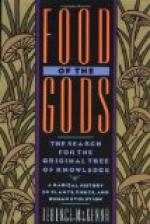FOOTNOTES:
[13] For ancient processes see Appendix I., p. 103.
[14] “Chocolate is an article so disguised in the manufacture that it is impossible to tell its purity or value. The only safeguard is to buy that which bears the name of a reputable maker.”—Chambers, “Manual of Diet.”
[15] The heart-leaved bixa, or anotta.
[16] Log-wood.
[17] The regulations adopted are so interesting that a place has been found for them in an Appendix (p. 106).
IV. ITS HISTORY.
[Illustration—Drawing: [From Dufour.] OLD DRAWING OF AN AMERICAN INDIAN, WITH CHOCOLATE-POT AND WHISK.]
Although now cultivated in many other tropical countries, the cacao tree is one of the New World’s rich gifts, first made known to our ancestors by the venturesome Spaniards, who probably became acquainted with its cultivation early in the sixteenth century, and spread the knowledge derived from the Mexicans and the inhabitants of Central America to their other colonies. They found cacao a more veritable mine of wealth than even the gold of which they procured such store. It is indeed a curious coincidence that in those countries of gold the cacao-beans were not only the form in which tribute was paid, but themselves passed as currency. On account of their use for this purpose by the Mexicans, Peter Martyr styled them amygdalae pecuniariae—“pecuniary almonds”—exclaiming: “Blessed money, which exempts its possessors from avarice, since it cannot be hoarded or hidden underground!”
Joseph Acosta tells us that “the Indians used no gold nor silver to trafficke in or buy withall ... and unto this day (1604) the custom continues amongst the Indians, as in the province of Mexico, instede of money they use cacao.” The Aztecs also made use of cacao in this way, as many as 8,000 beans being legal tender—rather a task, one would imagine, for the money-changers.
[Illustration—Black and White Plate: Native Americans Preparing and Cooking Cocoa. Ogibe’s “America,” 1671.]




